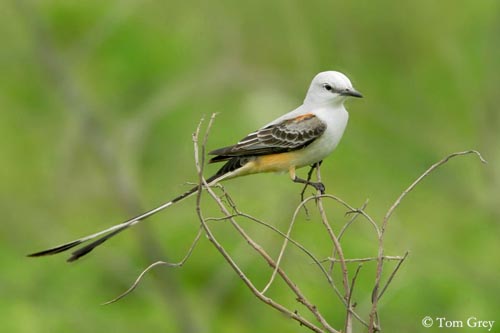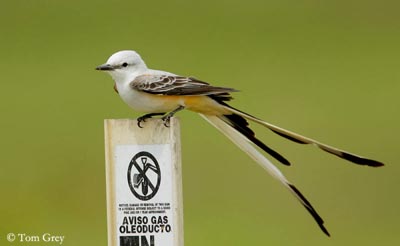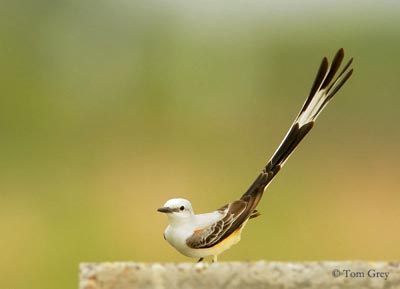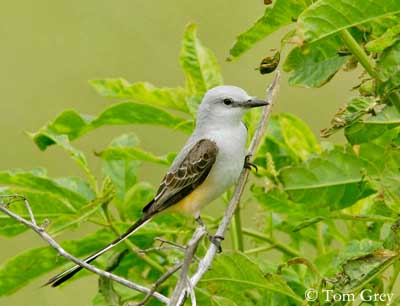
Scissor-tailed Flycatcher
Tyrannus forficatus
Passeriforme Order – Tyrannidae Family
BIOMETRICS:
Length: 19-38 cm (including the tail of about 11 cm long)
Wingspan: 36-39 cm
Weight: 39-40 g
DESCRIPTION:
Scissor-tailed Flycatcher is the state-bird of Oklahoma. The bird is displayed in flight to enhance the long forked tail.
Adult male has pale silvery grey head and upperparts. Back and rump are duller, mostly ash-grey tinged pink.
Wings are dark brown with conspicuous whitish edging on wing-coverts and secondaries. The reddish patch of axillaries is sometimes visible around the bend of wing when the bird is perched.
The long tail is deeply forked with blackish central rectrices. Outer tail feathers are longer, white and broadly tipped black.
Underparts are pale grey to white, tinged grey on the breast. The lower underparts are pink-orange. Underwing shows pink-orange to salmon coverts, with reddish patch on axillaries, well visible in flight.
The red coronal patch on the pale grey head is often semi-concealed.
The bill is straight and blackish. Eyes are dark brown with blackish lores. Legs and feet are black.
Fr: Tyran à longue queue
All : Scherenschwanz-Königstyrann
Esp: Tijereta Rosada
Ital: Tiranno codaforcuta settentrionale
Nd: Zwaluwstaart-koningstiran
Russe: Ножницехвостый мухолов
Sd: Saxstjärtstyrann
Photographs by Tom Grey
Tom Grey's Bird Pictures
Text by Nicole Bouglouan
Sources:
HANDBOOK OF THE BIRDS OF THE WORLD Vol 9 - by Josep del Hoyo - Andrew Elliot - David Christie - Lynx Edicions - ISBN: 8487334695
A GUIDE TO THE BIRDS OF MEXICO AND NORTHERN CENTRAL AMERICA by Steve N. G. Howell, Sophie Webb - Oxford University Press - ISBN: 0198540124
All About Birds (Cornell Lab of Ornithology)
What Bird-The ultimate Bird Guide (Mitchell Waite)
Wikipedia (Wikipedia, The Free Encyclopedia)

Female has similar plumage but duller, with paler pink areas, absent coronal patch and shorter tail and primaries.
Juvenile resembles female but paler, with greyish-brown duller upperparts, paler pinkish tinge below, much shorter tail, and it lacks the crown patch.
It has the adult plumage through the first winter, but the tail is still short in spring.
VOICE: SOUNDS BY XENO-CANTO
Scissor-tailed Flycatcher utters sharp, harsh, repeated “kee-kee-kee-kee”, a more nasal “bik err”, some sharp, dry “pik”, “kip” or kek”, and buzzy chattering.
At dawn, the male sings, giving several “pup” calls followed by “perleep”, also given during the flight displays.
We can also hear bill-snapping during aggressive displays and wing-whirring may be heard at close range.
HABITAT:
Scissor-tailed Flycatcher frequents open and semi-open country, semi-arid brushy scrub, savannahs and grasslands with scattered trees, roadsides, chaparral, forest edges, cultivated fields, pastures and urban parks.
It frequents more humid areas in winter. It is mainly seen at low elevation, but also up to 1500 metres.
RANGE:
Scissor-tailed Flycatcher breeds from eastern Colorado and Nebraska, south to Texas and Louisiana.
It winters in southern Florida and in Pacific slopes of Central America.

BEHAVIOUR:
Scissor-tailed Flycatcher feeds primarily on insects and few berries. Its diet includes mainly grasshoppers and crickets, beetles, spiders, dragonflies and mantids.
It also takes berries, and large groups gather in trees during migrations or in winter.
It is usually seen alone or in pairs during the breeding season, but in winter and during migrations, they often form various-sized flocks.
Scissor-tailed Flycatcher hunts on the wing and catches flying insects, performing aerial hawking from a perch and long sallies when pursuing a prey. It also gleans insects from the vegetation and sometimes from the ground.

FLIGHT:
Scissor-tailed Flycatcher performs light buoyant flight with shallow wing beats. The long outer rectrices allow the bird to forage mainly with aerial manoeuvres. The tail is actively used during the acrobatic flight displays, including reverse somersaults.
REPRODUCTION:
Breeding season occurs from March-April to August.
The nest is often placed in fairly exposed place, near foliage for the shade, up to 8 metres above the ground. It is in isolated tree or large bush, or even in artificial structures.
The nest is a thick-rimmed open cup made with twigs, stems, paper, string, cocoons of caterpillars, bark and feathers. The interior is lined with finer materials such as rootlets, grass and hair.
Scissor-tailed Flycatcher may nest in close proximity to other species. It is monogamous.

Female lays 4-5 white eggs with red, brown, olive and grey markings. Incubation lasts about 13-16 days, by female alone. Chicks are fed by both parents, and fledge about 14-17 days later.
The nest may be destroyed by strong wings and storms in some years.
DIET:
Scissor-tailed Flycatcher feeds primarily on insects, mainly grasshoppers and crickets. It hawks flying insects from perches, performs sallies and pursues the preys in the air. It also catches invertebrates on the ground and takes some berries.
PROTECTION / THREATS / STATUS:
Scissor-tailed Flycatchers take advantage of the degradation of forest, giving them more expanded breeding areas.
But the species is vulnerable to bad weather such as strong winds and tornados, to pesticides and removal of nest-sites in mesquite brush.
However, the populations seem to be stable with some local declines.
The very long tail of the male is used during the courtship displays, and mainly in aerial displays named “sky dance”. Males perform this flight soon after they arrive at breeding areas.
The male climbs about 30 metres in the air, and performs series of V-shaped flights. Then, it plunges down in an erratic zigzag flight display, while uttering rolling calls. This dance is a “very graceful aerial ballet” in which the long tail follows the flight pattern.
Scissor-tailed Flycatcher is gregarious but during the breeding season, the territory is defended against predators and intruders.
This species is migratory. During the migrations, the birds roost in large flocks, sometimes with other species in large trees near towns.